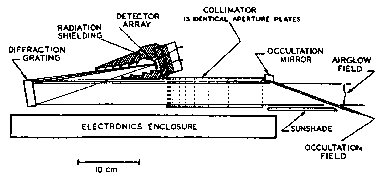mission / spacecraft / instruments
Ultraviolet Spectrometer (UVS)
The UVS is a very specialized type of light meter that is sensitive to ultraviolet light. It determines when certain atoms or ions are present, or when certain physical processes are going on. The instrument looks for specific colors of ultraviolet light that certain elements and compounds are known to emit.
The Sun emits a large range of colors of light. If sunlight passes through an atmosphere, certain elements and molecules in the atmosphere will absorb very specific frequencies of light. If the UVS, when looking at filtered sunlight, notices the absence of any of these specific colors, then particular elements and/or compounds have been detected. This process is call identifying elements or compounds by atomic absorption.
The Ultraviolet Spectrometer (UVS) covers the wavelength range of 40 nm to 180 nm looking at planetary atmospheres and interplanetary space.
 A sideways diagram of the UVS
A sideways diagram of the UVS
Ultraviolet Spectrometer (UVS) Objective
- To determine the scattering properties of the lower planetary atmospheres.
- To determine the distribution of constituents with height.
- To determine the extent and distribution of hydrogen corona of the planets and satellites.
- To investigate night airglow and auroral activity.
- To determine the UV scattering properties and optical depths of planetary rings.
- To search for emissions from the rings and from any ring "atmosphere."
